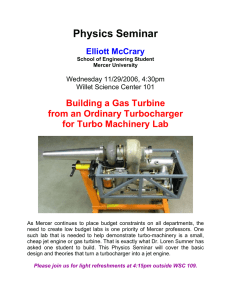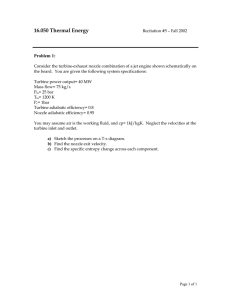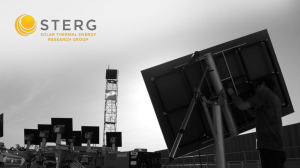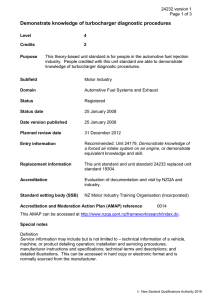cfd analysis on electric current generation from
advertisement
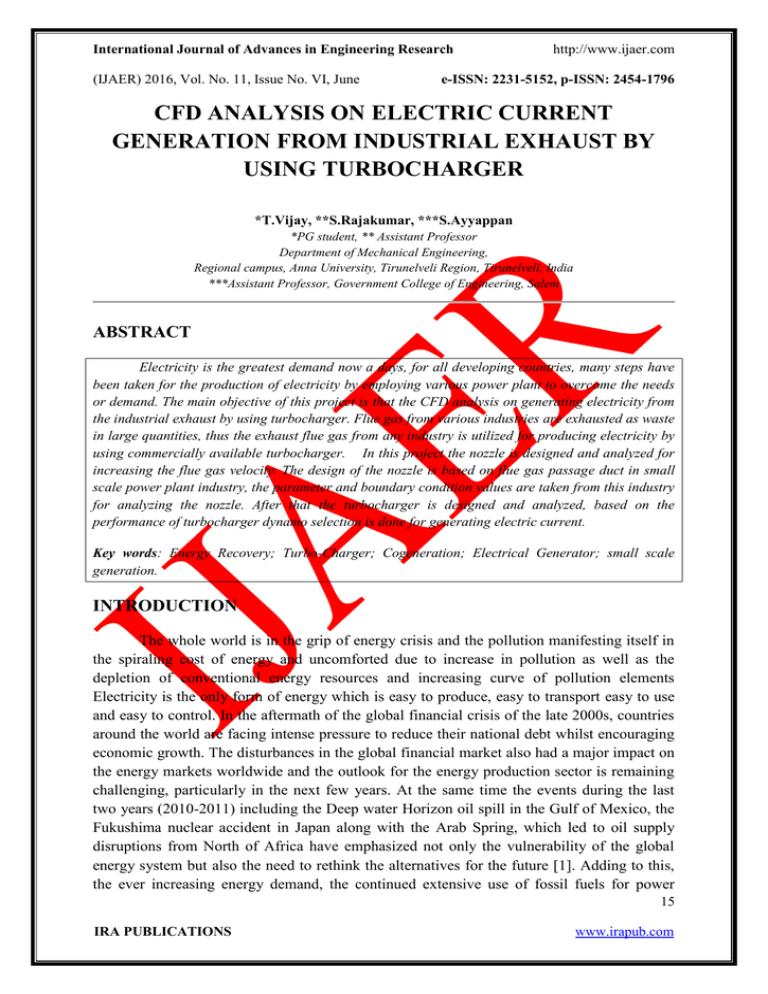
International Journal of Advances in Engineering Research (IJAER) 2016, Vol. No. 11, Issue No. VI, June http://www.ijaer.com e-ISSN: 2231-5152, p-ISSN: 2454-1796 CFD ANALYSIS ON ELECTRIC CURRENT GENERATION FROM INDUSTRIAL EXHAUST BY USING TURBOCHARGER *T.Vijay, **S.Rajakumar, ***S.Ayyappan *PG student, ** Assistant Professor Department of Mechanical Engineering, Regional campus, Anna University, Tirunelveli Region, Tirunelveli, India ***Assistant Professor, Government College of Engineering, Salem ABSTRACT Electricity is the greatest demand now a days, for all developing countries, many steps have been taken for the production of electricity by employing various power plant to overcome the needs or demand. The main objective of this project is that the CFD analysis on generating electricity from the industrial exhaust by using turbocharger. Flue gas from various industries are exhausted as waste in large quantities, thus the exhaust flue gas from any industry is utilized for producing electricity by using commercially available turbocharger. In this project the nozzle is designed and analyzed for increasing the flue gas velocity. The design of the nozzle is based on flue gas passage duct in small scale power plant industry, the parameter and boundary condition values are taken from this industry for analyzing the nozzle. After that the turbocharger is designed and analyzed, based on the performance of turbocharger dynamo selection is done for generating electric current. Key words: Energy Recovery; Turbo-Charger; Cogeneration; Electrical Generator; small scale generation. INTRODUCTION The whole world is in the grip of energy crisis and the pollution manifesting itself in the spiraling cost of energy and uncomforted due to increase in pollution as well as the depletion of conventional energy resources and increasing curve of pollution elements Electricity is the only form of energy which is easy to produce, easy to transport easy to use and easy to control. In the aftermath of the global financial crisis of the late 2000s, countries around the world are facing intense pressure to reduce their national debt whilst encouraging economic growth. The disturbances in the global financial market also had a major impact on the energy markets worldwide and the outlook for the energy production sector is remaining challenging, particularly in the next few years. At the same time the events during the last two years (2010-2011) including the Deep water Horizon oil spill in the Gulf of Mexico, the Fukushima nuclear accident in Japan along with the Arab Spring, which led to oil supply disruptions from North of Africa have emphasized not only the vulnerability of the global energy system but also the need to rethink the alternatives for the future [1]. Adding to this, the ever increasing energy demand, the continued extensive use of fossil fuels for power 15 IRA PUBLICATIONS www.irapub.com International Journal of Advances in Engineering Research (IJAER) 2016, Vol. No. 11, Issue No. VI, June http://www.ijaer.com e-ISSN: 2231-5152, p-ISSN: 2454-1796 production and the world’s obligation to reduce emissions, the extent of this challenge could be of far greater magnitude than expected. TURBOCHARGERS A turbochargeris a turbine-driven forced induction device that increases an internal combustion engine's efficiency and power output by forcing extra air into the combustion chamber. Turbochargers are commonly used on truck, car, train, aircraft, and construction equipment engines. They are most often used with Otto cycle and Diesel cycle internal combustion engines. They have also been found useful in automotive fuel cells. ENERGY RECOVERY Since then, many investigations were carried out by a number of researchers on the turbochargers and energy recovery from various industries. NikolettSipöcz, Alvaro Hernandez-Nogales, Miguel A. Gonzalez-Salazar, Roger Shisler, VitaliLissianski [1] authors investigated on Carbon dioxide ( ) capture and storage (CCS) from the flue gas which released from various industries.Thus, the conclusion of this project is to finding existing applications for next generation capture technologies at the small to medium-scale provides an important intermediate step for demonstrating and gaining the necessary knowledge required for further scaling up of novel CCS technologies. Bobby P. James and Bashar Zahawi [2] Authors investigated The development of cleaner, more efficient ways to power our homes and businesses is vital if we are to address climate change and energy security issues. This paper presents the design, construction and testing of a 1 kW, cylindrical high speed permanent magnet synchronous generator for use in a domestic combined heat and power (CHP) system, employing a turbocharger operating as a small gas turbine. Thus this paper concludes high on speed test results are included together with a critical speed analysis of the generator set. Mehari.WeldemariamDegefa, Solomon TesfamariamTeferi[3] has developed a system to recover part of the energy of exhaust air from an axial fan of 75kW using a Horizontal Axis Wind Turbine is discussed in this paper. The actual air data at the fan outlet are collected from central air conditioning station of a composite textile mill (Kombolcha Textile Share Company) using log-Tchebycheff method. Since the air flow type determines the steps in progress the air flow type is arithmetically found to be fully turbulent. A duct is designed to correct the air turbulence and transport the exhaust air from the fan to the turbine. By turning what was exhausted to useable form 5.7kW of electric power can be harvested. As there are vast application areas of industrial air system, utilizing the exhaust from such air systems as energy resource could be helpful and used as supplementary power for industry production floor lighting and little power supply requiring auxiliary processes. 16 IRA PUBLICATIONS www.irapub.com International Journal of Advances in Engineering Research (IJAER) 2016, Vol. No. 11, Issue No. VI, June http://www.ijaer.com e-ISSN: 2231-5152, p-ISSN: 2454-1796 DESIGN ANALYSIS In this project the turbocharger should be driven by flue gas exhaust, so the flue gas should possess some driving force thus this force is attains by providing a convergent nozzle to the flue gas flow, which increases the velocity of the flue gas. Thus the design aspect of convergent nozzle is based on flue gas passage duct in industry and the inlet of turbocharger. The small scale power plant is investigated for this project purpose according to this investigation area of flue gas passage duct is 160×130 cm which is taken as inlet area of the nozzle. Thus inlet area of turbocharger is taken as exit area of nozzle which is 10×6 cm MODELLING Model is a Representation of an object, a system, or an idea in some form other than that of the entity itself. A model is similar to but simpler than the system it represents.Generally, a model intended for a simulation study is a mathematical model developed with the help of simulation software such as Solid works, Creo, CATIA, Unigraphics, etc. Thus the modelling of convergent nozzle is done by using software CATIA V5 which is shown below. Fig 1:Modeling of nozzle and turbine ANALYSIS AND RESULTS The CFD analyze of convergent nozzle which is modeled is done by using software ANSYS 15.1.Computational fluid dynamics or CFD is the analysis of systems involving fluid flow, heat transfer and associated phenomena such as chemical reactions by means of computer-based simulation. The technique is very powerful and spans a wide range of industrial and non-industrial application areas.Thusthe analysis for various parameters such as velocity, temperature, density and pressure is shown below, 17 IRA PUBLICATIONS www.irapub.com International Journal of Advances in Engineering Research (IJAER) 2016, Vol. No. 11, Issue No. VI, June http://www.ijaer.com e-ISSN: 2231-5152, p-ISSN: 2454-1796 Velocity contourPressure contourDynamic pressureDensity analysis Fig 2: CFD analysis of nozzle Table 1: Result from the CFD analysis of convergent nozzle Parameter At inlet At exhaust Velocity (m/s) 22 293 Dynamic pressure(pa) 7.02× 2.22× Temperature (k) 300 303.5 Density (kg/ ) 4.27× 5.26× ANALYSIS AND RESULT OF TURBINE Thus,the above resultant value of convergent nozzle has been taken as the inlet value for analyzing turbine of turbocharger. 18 IRA PUBLICATIONS www.irapub.com International Journal of Advances in Engineering Research (IJAER) 2016, Vol. No. 11, Issue No. VI, June http://www.ijaer.com e-ISSN: 2231-5152, p-ISSN: 2454-1796 Pressure analysis Density analysis Velocity contour Fig 3: CFD analysis ofturbine Formula for finding the RPM of turbine N= Where, U-velocity of the fluid flow (m/s) D- Diameter of the turbine (m) N-rotational speed of the turbine (rpm) Thus from the analysis of turbine by using ANSYS 15.1software we found that the velocity of fluid is approximately 100 m/s. The diameter of the turbine is 0.07m ,then by using above formula we found that rotational speed of the turbine is 27,297 rpm. Dynamo selection The shaft of the turbine should be coupled with the dynamo. Thus, the dynamo will approximately rotates at 27,297 rpm. Formula for finding generated EMF of the DC dynamo = Where -Flux per pole (wb) Z-number of armature conductors = Number of slots X conductors per slot. P-Number of poles A- Number of parallel paths in armature. (A= P for lap wound armature; A=2 for wave wound armature) -Generated EMF 19 IRA PUBLICATIONS www.irapub.com International Journal of Advances in Engineering Research (IJAER) 2016, Vol. No. 11, Issue No. VI, June Dynamo type Lap wound Wave wound Lap wound Wave wound http://www.ijaer.com e-ISSN: 2231-5152, p-ISSN: 2454-1796 Table 2: Results of dynamos at various modes Flux per pole Number of Number of (wb) Pole armature conductor 0.025 4 432 0.025 4 432 0.020 8 960 0.020 8 960 Generated EMF (kv) 4.913 9.826 8.735 34.940 CONCLUSION The exhaust gas from the industries are utilized for electricity production by reducing emissionby using turbo charger. The nozzle was designed such that the flue gas velocity is increased from 20 m/s to 293 m/s. This high velocity flue gas is directed towards the turbo charger located at the nozzle exhaust thus it produces electricity depends upon the dynamo. For the lap wound and wave wound having 4 poles it produces 4.9 KV and 9.8 KV respectively. The lap wound and wave wound having 8 poles produces 8.7 KV and 34.9 KV respectively. REFERENCES 1) 2) 3) 4) 5) 6) NikolettSipöcz, Alvaro Hernandez-Nogales, Miguel A. Gonzalez-Salazar ,Roger Shisler, VitaliLissianski (2013), “Low temperature CO2 capture for near-term applications” Energy Procedia 37 ( 2013 ) 1228 – 1238 Bobby P. James and basharzahawi ,mediterranean green energy forum 2013,” high speed generator for turbocharger based domestic combined heat and power unit employing the inverted brayton cycle” energy procedia 42 ( 2013 ) 249 – 260 . MehariWeldemariamDegefa, Solomon TesfamariamTeferi(2014), “Energy recovery from exhaust air of textile industry”, International Journal of Renewable andSustainableEnergy.Vol.3,No.4,2014,pp.82-86. doi:10.11648/j.ijrse.20140304.12 Eduardo mariscal-hay, noel leon-rovira (2013),” electrical generation from thermal solar energy using a turbocharger with the brayton thermodynamic cycle”, 2013 ISES solar world congress K.Balaji and R.Ramkumar,“study of waste heat recovery from steam turbine exhaust for vapour absorption system in sugar industry”,procedia engineering 38 ( 2012 ) 1352 – 1356. Maria sanchez del rioa, mathieulucquiauda, jongibbinsa,” maintaining the power output of an existing coal plant with the addition of co2 capture: retrofits options with gas turbine combined cycle plants”, energy procedia 63 ( 2014 ) 2530 – 2541 20 IRA PUBLICATIONS www.irapub.com International Journal of Advances in Engineering Research (IJAER) 2016, Vol. No. 11, Issue No. VI, June http://www.ijaer.com e-ISSN: 2231-5152, p-ISSN: 2454-1796 C. Casarosa , F. Donatini , A. Franco ,”thermoeconomic optimization of heat recovery steam generators operating parameters for combined plants”, energy 29 (2004) 389–414 8) Wei-hsianglai,chi-an hsiao, chien-hsiung lee , yau-pin chyoub, yu- chingtsai “experimental simulation on the integration of solid oxide fuel cell and micro-turbine generation system “,journal of power sources 171 (2007) 130–139 9) Rodolfo bontempoa, massimo cardonea, marcello mannaa, giovanni vorraroa ”Highly flexible hot gas generation system for turbocharger testing”, energy procedia 45 ( 2014 ) 1116 – 1125 10) Gequnshu,youcailiang,haiqiaowei , huatian,jianzhao,linaliu “a review of waste heat recovery on two-stroke ic engine aboard ships “,renewable and sustainable energy reviews 19 (2013) 385–401 11) DING xianfei, XU bin,” study on regulating law of two-stage turbo charger system of piston aircraft engine”, procedia engineering 17 (2011) 581 – 586 12) Bernhard schweizer,” total instability of turbocharger rotors physical explanation of the dynamic failure of rotors with full-floating ring bearings “, journal of sound and vibration 328 (2009) 156–190. 13) PengGeng, Chunde Yao , Quangang Wang, Lijiang Wei, Junheng Liu, Wang Pan, Guopeng, “Han Effect of DMDF on the PM emission from a turbo-charged diesel engine with DDOC and DPOC”, Applied Energy 148 (2015) 449–455. 14) M.H. Padzillah , S. Rajoo , M. Yang , R.F. Martinez-Botas,“Influence of pulsating flow frequencies towards the flow angle distributions of an automotive turbocharger mixed-flow turbine”, Energy Conversion and Management 98 (2015) 449–462. 15) SritharRajoo , Alessandro Romagnoli , Ricardo F. Martinez-Botas ,“Unsteady performance analysis of a twin-entry variable geometry turbocharger turbine”, Energy 38 (2012) 176e189 16) https://www.google.co.in/ turbocharger 17) https://www.google.co.in/properties of flue gas 7) 21 IRA PUBLICATIONS www.irapub.com
